It’s been almost exactly seven years since Donald Trump celebrated his huge victory in the Nevada caucuses by extolling the virtues of the “poorly educated.” “We won with highly educated. We won with poorly educated. I love the poorly educated,” Trump said Feb. 23, 2016.
And voters with less formal education loved him back, delivering Trump some of his biggest margins among any demographic group as he was securing the GOP nomination — even as college-educated voters were somewhat less sold on him.
The education gap is looking even bigger ahead of the 2024 primaries. Indeed, it might be the story of a prospective matchup between Trump and Florida Gov. Ron DeSantis (R).
A series of recent polls suggest there might be no bigger difference between support for Trump and support for DeSantis than education (and, relatedly, income). College-educated voters are significantly more favorable to DeSantis personally, and they favor him by wide margins in head-to-head matchups.
A recent Quinnipiac University poll showed Trump leading by nine points (47 percent to 38 percent) in a crowded field among those without four-year college degrees, but DeSantis leading by 34 (56 percent to 22 percent) among those with degrees.
In a one-on-one matchup, Monmouth University also showed DeSantis leading by a 34-point margin among those with four-year degrees (60-26), while leading by five points (50-45) among those without.
The varying views of the candidates by education level are also seen in a Marist College poll. It showed GOP-leaning voters without college degrees had overwhelmingly positive views of Trump and DeSantis; their favorable ratings were each about 50 points higher than their unfavorable ratings. But college-educated voters were even more favorable to DeSantis, 74 percent to 10 percent, compared with 63-30 for Trump.
The 30 percent of college-educated voters who had an unfavorable view of Trump was higher than any other demographic broken out in the poll, except GOP-leaning independents (33 percent).
Recent polls in California and New Hampshire also show the steady and sharp decline in Trump’s support as you increase education level.
A University of California at Berkeley poll released Friday showed Trump’s share of that state’s primary vote dropping from 45 percent among voters who had high school degrees or less, to 31 percent among those who had attended some college or a trade school, to 21 percent among college graduates, and 15 percent among those who did postgraduate work.
DeSantis led among each group that had more than a high school education, including by more than 20 points among those with at least a college degree.
The same trend was evident in the University of New Hampshire poll of Granite State voters. Among the same groups, Trump’s support dropped from 41 percent (high school or less) to 31 percent (some college or trade school) to 16 percent (college) to 15 percent (postgraduate).
These gaps, it bears emphasizing, are bigger than they were in 2016.
The Associated Press ran an analysis in April 2016 with data from 20 state exit and entrance polls. It also showed Trump’s support dropping as education increased, but not by quite as much. It went from 47 percent to 42 percent to 35 percent to 27 percent. And he still led in every group.
If there’s good news for Trump, it’s that voters with less formal education have trended toward the GOP. Whereas White, non-college-educated voters were about evenly split between the parties as recently as 2008, they favored the GOP by about 25 points in a 2019 Gallup survey. White, college-educated voters’ share of the party has shrunk to about 25 percent in 2019, according to data from the Pew Research Center.
But it’s also true that people are much more likely to vote as their education level increases — meaning those voters are overrepresented in primaries. In many states in 2016, a slight majority of GOP primary voters had either a college degree or did postgraduate work.
If those voters choose DeSantis (or anyone else) over Trump by such large margins, Trump’s math becomes much more difficult.

